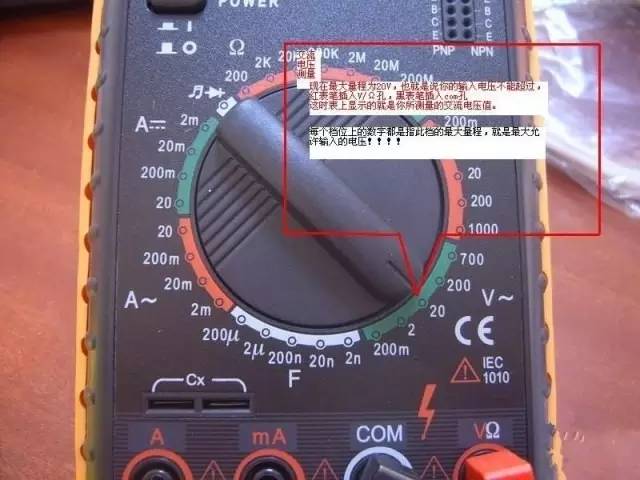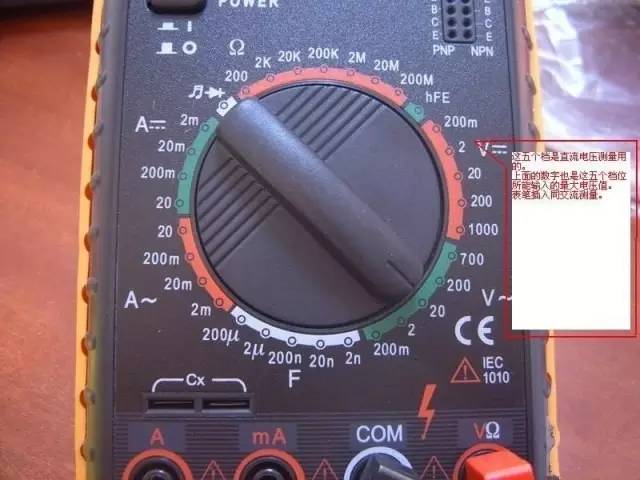

A multimeter, also known as a multimeter, three-use meter, or multifunction meter, is a versatile measuring instrument that can measure direct current (DC) current, direct voltage, alternating voltage, resistance, audio levels, and more. Some models can also measure AC current, capacitance, inductance, and certain parameters of semiconductors (such as β).
Measuring AC voltage: As shown in Figure 1, the maximum range is 20V, which means your input voltage must not exceed this. The red probe is inserted into the v/Ω socket, and the black probe is inserted into the com socket. The value displayed on the meter is the AC voltage you are measuring.

Figure 1
Figure 2 shows five ranges for measuring DC voltage.

Figure 2
The numbers on the top four ranges for DC measurement represent the maximum current values that can flow through these ranges, as shown in Figure 3.

Figure 3
These seven ranges are for measuring resistance, with the maximum resistance values indicated, as shown in Figure 4.

Figure 4
This range is used to test the functionality of diodes and to check for continuity, as shown in Figure 5.

Figure 5
Figure 6 is for measuring capacitance, with the maximum capacitance values indicated.

Figure 6
1. Structure of the Multimeter (Model 500)
The multimeter consists of three main parts: the meter head, measurement circuit, and selector switch.
(1) Meter Head
It is a highly sensitive magnetic electric DC ammeter. The main performance indicators of the multimeter largely depend on the performance of the meter head. The sensitivity of the meter head refers to the value of the DC current flowing through it when the pointer deflects to full scale; the smaller this value, the higher the sensitivity. The internal resistance when measuring voltage is larger, which enhances performance. The meter head has four scale lines with the following functions: The first line (from top to bottom) is marked R or Ω, indicating the resistance value, and is read when the selector switch is in the ohm range. The second line is marked ∽ and VA, indicating AC and DC voltage and DC current values, and is read when the selector switch is in the AC or DC voltage or current range, except for the AC 10V position. The third line is marked 10V, indicating the AC voltage value of 10V, and is read when the selector switch is in the AC or DC voltage range at 10V. The fourth line is marked dB, indicating audio levels.
(2) Measurement Circuit
The measurement circuit is used to convert various measurements into a suitable small DC current for the meter head. It consists of resistors, semiconductor components, and batteries.
It can convert various measurements (such as current, voltage, resistance, etc.) and different ranges into a small DC current sent to the meter head for measurement through a series of processes (such as rectification, shunting, and voltage division).
(3) Selector Switch
Its function is to select various measurement circuits to meet different types and ranges of measurement requirements. The selector switch generally has two positions, marked with different ranges and scales.
2. Symbol Meanings
(1) ∽ indicates AC and DC
(2) V-2.5KV 4000Ω/V indicates that for AC voltage and the 2.5KV DC voltage range, the sensitivity is 4000Ω/V
(3) A-V-Ω indicates that it can measure current, voltage, and resistance
(4) 45-65-1000Hz indicates that the frequency range is below 1000 Hz, with a standard frequency range of 45-65Hz
(5) 2000Ω/V DC indicates that the sensitivity for the DC range is 2000Ω/V
The symbols on clamp meters and shake meters are similar to the above symbols (others cannot be fully listed due to format issues).
3. Using the Multimeter
(1) Familiarize yourself with the meanings of the symbols on the dial and the main functions of each knob and selector switch.
(2) Perform mechanical zeroing.
(3) Depending on the type and size of the measurement, select the appropriate position and range on the selector switch, and find the corresponding scale line.
(4) Choose the position of the test lead sockets.
(5) Measuring Voltage:
When measuring voltage (or current), select the appropriate range. If a small range is used to measure a large voltage, there is a risk of damaging the meter; if a large range is used to measure a small voltage, the pointer will deflect too little to read. The range selection should aim to make the pointer deflect to about 2/3 of full scale. If the size of the voltage to be measured is unknown in advance, start with the highest range and gradually decrease to an appropriate range.
a Measuring AC Voltage: Set one selector switch to the AC/DC voltage position and the other to the appropriate AC voltage range, then connect the multimeter’s probes in parallel with the circuit or load being measured.
b Measuring DC Voltage: Set one selector switch to the AC/DC voltage position and the other to the appropriate DC voltage range, ensuring the “+” probe (red) connects to the high potential and the “-” probe (black) connects to the low potential, allowing current to flow from the “+” probe into the circuit and out from the “-” probe. If the probes are reversed, the meter’s pointer will deflect in the opposite direction, potentially damaging it.
(6) Measuring Current:
For measuring DC current, set one selector switch to the DC current position and the other to the appropriate range from 50uA to 500mA. The selection of current range and reading method is the same as for voltage. Before measuring, the circuit must be disconnected, and the multimeter must be connected in series with the circuit being measured, allowing current to flow from the red probe into the circuit and out from the black probe. If the multimeter is mistakenly connected in parallel with the load, the low internal resistance of the meter head could cause a short circuit, damaging the instrument. The reading method is as follows:
Actual value = Indicated value × Range / Full scale deflection
(7) Measuring Resistance: To measure resistance with a multimeter, follow these steps:
a Choose the appropriate range. The ohm scale of the multimeter is not uniform, so the range selection should allow the pointer to stop at a less dense part of the scale, and the closer the pointer is to the middle of the scale, the more accurate the reading. Generally, the pointer should be positioned between 1/3 and 2/3 of the scale.
b Zero the ohm setting. Before measuring resistance, short the two probes and adjust the “ohm (electric)” zeroing knob until the pointer indicates the zero position just to the right of the ohm scale line. If the pointer cannot be adjusted to zero, it indicates insufficient battery voltage or an issue with the instrument. Also, every time the range is changed, zeroing should be performed again to ensure accurate measurements.
c Reading: The reading of the meter head multiplied by the range gives the resistance value being measured.
(8) Precautions
a Do not change the range while measuring current or voltage under load.
b When selecting a range, start with a larger range before moving to a smaller one, aiming to keep the measured value close to the range.
c Do not measure resistance while the circuit is powered. When measuring resistance, the multimeter is powered by its internal battery, and measuring under power would effectively connect an additional power source, potentially damaging the meter head.
d When finished, set the selector switch to the maximum AC voltage position or the open position.
4. Digital Multimeter
Currently, digital measuring instruments have become mainstream and are trending to replace analog instruments. Compared to analog instruments, digital instruments are more sensitive, accurate, clear in display, have strong overload capacity, are easier to carry, and simpler to use. Below is a brief introduction to the usage and precautions of the VC9802 digital multimeter.
(1) Usage
a Before use, carefully read the relevant instruction manual and familiarize yourself with the functions of the power switch, range switch, sockets, and special connectors.
b Set the power switch to the ON position.
c Measuring AC and DC voltage: Set the range switch to the appropriate DCV (DC) or ACV (AC) position, insert the red probe into the V/Ω socket, the black probe into the COM socket, and connect the probes in parallel with the circuit being measured. The reading will be displayed.
d Measuring AC and DC current: Set the range switch to the appropriate DCA (DC) or ACA (AC) position, insert the red probe into the mA socket (for <200mA) or 10A socket (for >200mA), the black probe into the COM socket, and connect the multimeter in series with the circuit being measured. When measuring DC, the digital multimeter can automatically display the polarity.
e Measuring resistance: Set the range switch to the appropriate Ω range, insert the red probe into the V/Ω socket, the black probe into the COM socket. If the measured resistance exceeds the maximum value of the selected range, the multimeter will display “1”; at this point, a higher range should be selected. When measuring resistance, the red probe is positive, and the black probe is negative, which is the opposite of the analog multimeter. Therefore, when measuring polarized components such as transistors and electrolytic capacitors, the polarity of the probes must be observed.
(2) Usage Precautions
a If the size of the voltage or current to be measured is unknown, first set to the highest range and measure once, then gradually reduce to an appropriate position. After measuring, set the range switch to the highest voltage position and turn off the power.
b When at full scale, the instrument will only display the digit “1” in the highest position, with all other positions disappearing; at this point, a higher range should be selected.
c When measuring voltage, connect the digital multimeter in parallel with the circuit being measured. When measuring current, connect it in series with the circuit being measured, and when measuring DC, polarity does not need to be considered.
d When mistakenly using the AC voltage range to measure DC voltage, or vice versa, the display will show “000” or the digits at the lower position will fluctuate.
e Do not change the range while measuring high voltage (above 220V) or high current (above 0.5A) to prevent arcing and burning out the switch contacts.
f When the display shows “ ”, “BATT”, or “LOW BAT”, it indicates that the battery voltage is below the working voltage.
5. Shake Meter
The shake meter, also known as an insulation resistance meter, is used to measure the insulation resistance and high-value resistance of the equipment being tested. It consists of a hand-cranked generator, meter head, and three connection terminals (L: line terminal, E: ground terminal, G: shielding terminal).
1) Principles for Selecting a Shake Meter
(1) Selection of rated voltage levels. Generally, for equipment rated below 500V, a shake meter rated at 500V or 1000V should be selected; for equipment rated above 500V, select a shake meter rated between 1000V and 2500V.
(2) Selection of resistance range. The scale line on the shake meter has two small black dots; the area between these dots is the accurate measurement area. Therefore, when selecting a meter, ensure that the insulation resistance value of the equipment being tested falls within the accurate measurement area.
2) Using the Shake Meter
(1) Calibration. Before measuring, perform an open-circuit and short-circuit test on the shake meter to check if it is functioning well. Open the two connection wires, crank the handle, and the pointer should point to “∞”; then short the two connection wires, and the pointer should point to “0”. If both conditions are met, the meter is good; otherwise, it should not be used.
(2) Disconnect the equipment and circuit being measured, and discharge large capacitive devices.
(3) Select a shake meter with the appropriate voltage rating.
(4) When measuring insulation resistance, generally only the “L” and “E” terminals are used, but when measuring the insulation resistance of cables to ground or when the leakage current of the equipment being tested is severe, the “G” terminal should be used and connected to the shielding layer or casing. After connecting the circuit, turn the crank clockwise, starting slowly and gradually increasing speed. When the speed reaches about 120 revolutions per minute (for model ZC-25), maintain a constant speed, read the value after one minute, and make sure to read while cranking; do not stop to read.
(5) Discharge after reading. After reading, slowly crank while disconnecting the wires, then discharge the equipment being tested. The discharge method is to short the ground wire used during measurement to the equipment being tested (not discharging the shake meter).
3) Precautions
(1) Do not measure insulation resistance during thunderstorms or near high-voltage equipment; measurements should only be taken when the equipment is de-energized and free from induced voltage.
(2) No one should work on the equipment being tested during the shake measurement process.
(3) The shake meter wires should not be twisted together; they should be separated.
(4) Do not touch the meter or the equipment being tested before the shake meter has stopped turning or the equipment has been discharged. When disconnecting wires, do not touch the metal parts of the leads.
(5) After measuring, discharge large capacitive devices.
(6) Regularly calibrate its accuracy.
6. Clamp Meter
A clamp meter is an instrument used to measure the current in an energized electrical circuit without interrupting the circuit.
1) Structure and Principle
A clamp meter essentially consists of a current transformer, clamp-shaped wrench, and a rectifying magnetic electric meter with reaction force.
2) Usage
(1) Perform mechanical zeroing before measuring.
(2) Select the appropriate range, starting with a larger range and then selecting a smaller one or estimating based on the nameplate value.
(3) When using the smallest range, if the reading is not apparent, wrap the measured wire several times, with the number of turns based on the central area of the clamp jaws; then the reading = indicated value × range / full scale deflection × number of turns.
(4) Ensure the measured wire is centered in the clamp jaws and that they are tightly closed to reduce error.
(5) After measuring, set the selector switch to the maximum range position.
3) Precautions
(1) The voltage of the measured circuit must be below the rated voltage of the clamp meter.
(2) When measuring current on high-voltage lines, wear insulated gloves, insulated shoes, and stand on an insulated mat.
(3) The clamp jaws must be tightly closed, and the range should not be changed while the circuit is energized.
☞ Source: Chongqing Construction Training
☞ Edited by: Sonya
☞ Submission email: [email protected]. Contributions or leads adopted will be rewarded!
Must-Read Recent Articles
☞ Hydraulic Press vs. Diamond: Diamond Turns to Dust~
☞Finally Understand the Difference Between 100,000, 200,000, 500,000, 1,000,000 Cars!
☞ Dual Spindle with Dual Five-Axis Linked Worktable Stunning Processing, Amazing!
☞How to DIY a Lathe?
☞ The Working Principle of the World’s Largest Ship Lift Revealed
